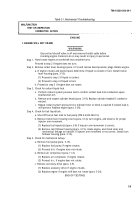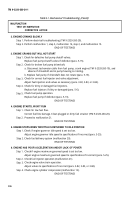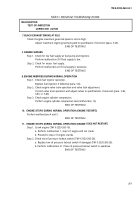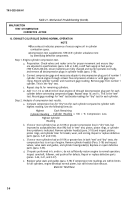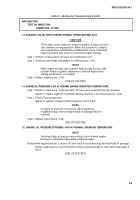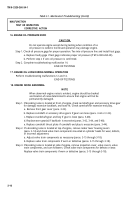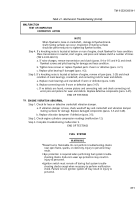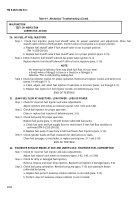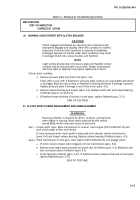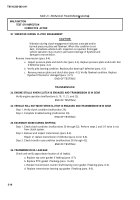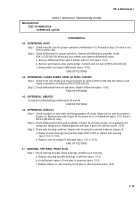TM-9-2320-260-34-1 - Page 29 of 657
TM 9-2320-260-34-1
Table 2-1. Mechanical Troubleshooting (Contd).
MALFUNCTION
TEST OR INSPECTION
CORRECTIVE ACTION
30.
BURNING ODOR EVIDENT WITH CLUTCH ENGAGED
CAUTION
Clutch engagement followed by a burning odor indicates clutch
improperly engaged and slipping. When this condition is evident,
inspection of vehicle clutch operation is required immediately.
Prolonged operation of vehicle under these conditions may result
in damaged clutch disc, pressure plate, and flywheel.
NOTE
Light surface discoloration of pressure plate and flywheel contact
surfaces may be removed with crocus cloth. Deeper discoloration
and hard spots on flywheel may require replacement of part.
Check clutch condition.
a.
b.
c.
Remove pressure plate and clutch disc (para. 4-2).
Clean with crocus cloth if flywheel or pressure plate surfaces are only slightly discolored
or damaged. Machine new surface on flywheel to limiting thickness if damage is greater.
Replace pressure plate if damage is more than minor (para. 4-2).
Remove release bearing and inspect (para. 4-3). Replace clutch disc and release bearing
if defective (paras. 4-2 and 4-3).
If flywheel shows evidence of burned or hard spots, replace flywheel (para. 3-21).
END OF TESTING!
31. CLUTCH NOISY DURING ENGAGEMENT AND DISENGAGEMENT
Step 1.
Step 2.
WARNIN G
Hearing protection is required for driver, co-driver, and mechanic
when engine is running. Noise levels produced by this vehicle
exceed 85dB, which may cause injury to personnel.
Check clutch noise. Place transmission in neutral. Start engine (TM 9-2320-260-10) and
push clutch pedal to floor and release.
If noise increases when clutch pedal is depressed and released, remove transmission
(para. 8-4) and inspect release bearing. Replace release bearing if defective (para. 4-3).
Place transmission in first gear, start engine (TM 9-2320-260-10), and engage clutch.
a.
b.
c.
If clutch noise increases when engaged, remove transmission (para. 8-4).
Remove and inspect pressure plate and clutch disc for defects (para. 4-2). Replace clutch
disc or pressure plate if defective (para. 4-2).
Verify flywheel condition (para. 3-21). If flywheel shows evidence of burned or hard spots,
replace flywheel (para. 3-21).
END OF TESTING!
2-15
Back to Top

